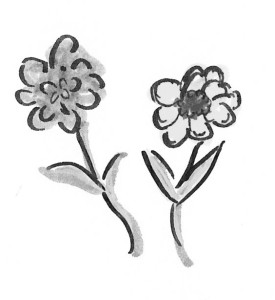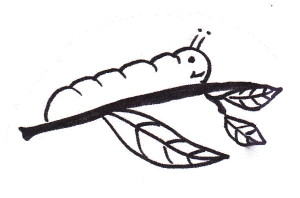My music sessions with children often aim to provide a musical basis for understanding the elements of narrative structure, including placing items in a logical sequence. Children’s knowledge of both fictional stories and non-fictional events, such as the growth of a plant, can be enhanced through musical exploration. Fisher and McDonald (2001) describe how teachers can have great success with sequencing songs such as “I Know an Old Lady Who Swallowed a Fly,” and “I Had an Old Coat,” the story of a tailor who gradually reduces his worn old coat down to the size of a button, making good use of the remains each time. In the “Old Lady” song, the items in the sequence get progressively larger, while in the “Old Coat,” they get smaller.
“The Green Grass Grew All Around,” a traditional American song familiar to most children, also employs a progressively smaller sequence, as does its Irish counterpart, “The Rattlin’ Bog.” One time my daughter and I started with a tree in the song and sang it all the way down to a quark. In Raffi’s “I’m Being Swallowed by a Boa Constrictor,” the song’s sequence progresses up the body, from the toes to the head, as the singer gets gradually swallowed up!
Placing items in a logical sequence is a key organizational skill useful in every academic discipline. Science is grounded in concepts of order and sequence. Mathematics relies on the understanding of various number sequences and patterns. Social Studies employs timelines and asks the learner to consider how a particular sequences of events might lead to certain changes in society. And of course, fictional stories have a beginning, middle and end.
Musical pieces, too, form patterns and sequences that lead the listener through various iterations of a theme or themes before a piece reaches its conclusion. I feel sure my music teacher friends could expand on teaching about musical themes and variations or ABAB patterns.  For my own purposes, I often combine song lyrics and musical patterns to teach concepts in other academic disciplines. In the springtime, I teach a simple song, Nancy Hershatter’s “Once I was a Seed,” that employs movement and a major scale to teach children about the growth of a seed into a flower. The children begin the song curled up on the floor as seeds. As the scale progresses, the song’s lyrics invite them to look up at the sun, drink some water (from a rain stick – kids love it!), sprout leaves (while starting to stand up) and finally reach for the sky.
For my own purposes, I often combine song lyrics and musical patterns to teach concepts in other academic disciplines. In the springtime, I teach a simple song, Nancy Hershatter’s “Once I was a Seed,” that employs movement and a major scale to teach children about the growth of a seed into a flower. The children begin the song curled up on the floor as seeds. As the scale progresses, the song’s lyrics invite them to look up at the sun, drink some water (from a rain stick – kids love it!), sprout leaves (while starting to stand up) and finally reach for the sky.
Sarah Pirtle’s song, “A Seed Knows What to Do,” provides rhyme, rhythm and a tune to tell a more elaborate story of a garden, beginning in late winter and ending with the fall’s harvest. The song, on her album Pocketful of Wonder, repeats a refrain reminds students of the central theme, the simple miracle of nature that seeds “know what to do.”
With my song, “If I Were a Butterfly,” children are invited to imitate the motion of a butterfly fluttering about the room. It can be done as a finger play or as a movement game using the whole body. The melody of the song follows the butterfly; when the notes go higher, the butterfly flies higher; when they go lower, the butterfly flutters down and touches the ground.
During the first verse of the song, the children are encouraged to show how the butterfly begins as a caterpillar, then cuddles up small into a chrysalis. As the spring sun shines down, the chrysalis opens up and out comes the butterfly, fluttering around again.
The song’s second verse weaves together bits of information about butterflies, including how they help flowers grow, where they live, and what colors they are. The song creates a list of content topics similar to what a teacher would create with students during a classroom unit. Children can be encouraged to develop each of the topics with further research, reading, drawing or writing. They can also act out the different topics of the song, showing how butterflies spread nectar in a flower garden and live in different climates and places.
In my music sessions, children often wave scarves in the different butterfly colors. This activity is a special favorite among the students in my combined classes that include children with significant physical disabilities. The scarves provide eye-catching colors and children in wheelchairs have fun waving them and playing with them in a variety of ways, then covering up with the scarf to be the chrysalis. A success at every level!






Great ideas Liz. Thank you…..